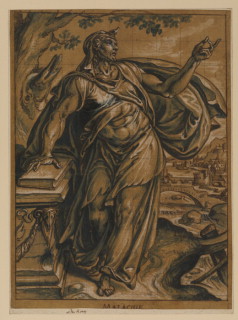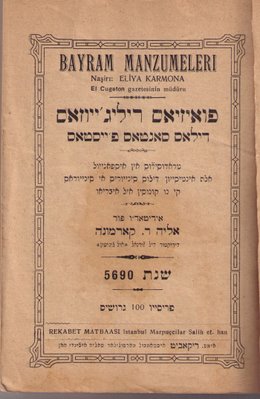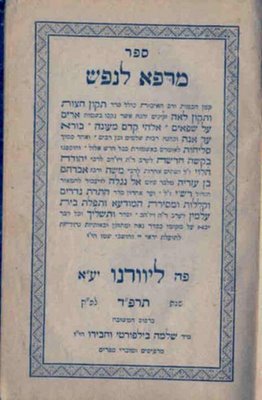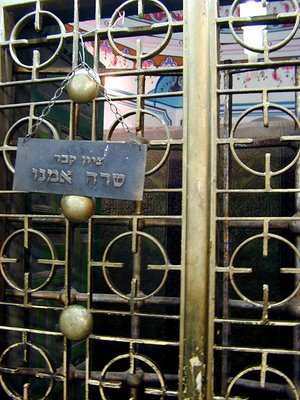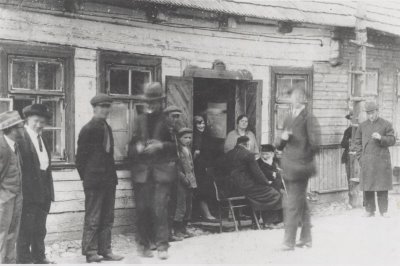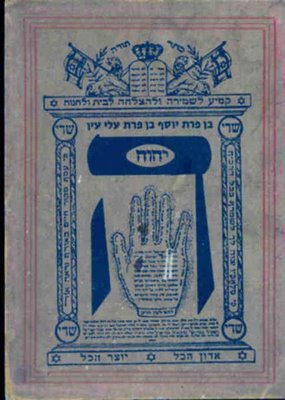
 Hilulah Day: Elul-13 Rabbi Yosef Chaim - The Ben Ish Chai
Hilulah Day: Elul-13 Rabbi Yosef Chaim - The Ben Ish ChaiBorn: Baghdad, Iraq, 1834 (27th of Av)
Died: Gez, Iraq, 1909
Halachist, Darshan (preacher), Kabbalist
Rabbi Yosef's phenomenal gifts were obvious from his earliest childhood. At the age of four, his father Rabbi Eliyahu Chaim asked him, "Why did God ask Adam, 'Where are you?'" (Genesis 3:9). The child replied that the letters of the Hebrew word for "where are you" spell out the acronym of the Hebrew words "I know all secrets" - a hint to Adam that God knew exactly what had happened.
When Rabbi Yosef was 14 years old, an incident occurred that spread his fame as far as the Holy Land. One day he noticed a letter in his home with a halachic question posed by the rabbis of Jerusalem to his father R' Eliyahu. He immediately understood the problem and sent off an answer the very same day, without his father's knowledge. When the rabbis read the answer, they immediately agreed to the decision and acted accordingly. A few days later, R' Eliyahu's own answer arrived with exactly the same decision as his son's. Only then did the rabbis realize what had happened. They immediately wrote to R' Eliyahu declaring their wonder at the phenomenal ability of his son.
At the age of 15 R' Yosef entered the yeshivah of his grandfather's greatest disciple, Rabbi Abdallah (Ovadyah Avraham) Somech (1813-1889), whom he later regarded as his foremost teacher. His stay in the Yeshivah did not last long, however, for he soon removed himself from the public eye. He secluded himself day and night in a small room of his father's house, where he immersed himself in the study of Torah. Later he had a mikveh constructed in the courtyard of his house in order to be able to immerse himself whenever he wished without attracting attention to his austere schedule.
At the age of 18, R' Yosef married Rachel the daughter of Yehudah Somech, a relative of his revered teacher, R' Abdallah.
R' Yosef's name spread far and wide, and he became known to the rabbis of Saloniki, Izmir, and Constantinople. He corresponded with scholars in Eastern Europe. When he was only 23 years old, Rabbi Chaim Palaggi (d. 1873), the senior Rabbi of Izmir (Turkey) and author of dozens of Halachic and Aggadic works, addressed questions to him and praised his writings.
In 1859, upon the death of his father, R' Yosef was offered the leadership of the community of Baghdad, even though he was only 26 years old. Like his father before him, R' Yosef accepted only the official position of Darshan (preacher), and without a stipend, preferring to rely on a partnership in his brothers' business for income.
Nevertheless, nothing was done in the community without his consent; his word was final among scholars and simple people alike.
Within a short period, R' Yosef Chaim's influence spread to Iran and Kurdistan, and the contents of his lectures were published in the newspapers of the Baghdadi communities as far away as Bombay, Rangoon, Singapore, Hong Kong, and Sidney. Halachic questions soon began to pour in from Jews throughout the Middle and Far East. Many of his answers were later printed in his monumental four-volume collection of responsa, Rav Pe'alim.
With the publication of his Halachic works, R' Yosef became known even further abroad. In faraway Jerba, an island off the coast of Tunisia with an extremely ancient and scholarly community, R' Yosef Chaim was referred to simply as "the Gaon" despite the community's usual restraint in praising living scholars. Rabbi Matzliach Mazz, and outstanding Jerban scholar and contemporary of R' Yosef, writes in one his books : "everything that R' Yosef Chaim writes in his works is greatly valued by us and is accepted as if it were handed down explicitly from Mount Sinai."
R' Yosef Chaim devoted some time each day to lecturing. Every morning, after completing the shacharit prayer, he would deliver a lecture in Talmud in the Small Synagogue. He laid special emphasis on explaining the Aggadic passages of the Talmud. In time, his expositions of these passages were published in Ben Yehoyada (five volumes), followed some years later by a second work, Benayahu.
The lecture in Talmud was followed by a half-hour lecture on the Shulchan Aruch.
In 1860, he began to deliver a 3 hour lecture every Shabbat afternoon on topics connected with the subject of the weekly Torah reading. A sample of the contents of the lectures of the first four years is contained in his Aderet Eliyahu. Beginning in 1870, he also devoted time in his Shabbat lectures to Halachic rulings. Much of the Halachic content of these lectures later formed the basis of his most famous work, the Ben Ish Chai, and its supplement, Od Yosef Chai. Due to the popularity of this book, R' Yosef Chaim came to be known by its name and today he is referred to universally as the
Ben Ish Chai. R' Yosef's weekly lectures were attended by the majority of the community and were topics of study and discussion throughout the following week.
Four times a year, on Shabbat Shuvah (the Shabbat before Yom Kippur), Shabbat Zachor (the Shabbat before Purim), Shabbat HaGadol (the Shabbat before Pesach) and Shabbat Kallah (the Shabbat before Shavuot), Rabbi Yosef Chaim would deliver a four hour lecture in the Great Synagogue. As the official Darshan of the city, he inherited from his father the exclusive right to lecture on these four occasions, and all other synagogues in the city were closed. A small portion of the content of these lectures was later published in Ben Ish Chayil. Perhaps his most interesting lecture of the year was delivered on the morning of Purim. In the course of the lecture, he would explain every minute detail of the story of the megillah, as found in the Midrash and Talmud; and when describing how Haman sold himself as a slave to Mordechai, he would enact the part in great detail, to the hilarity of the audience. He himself remained deadly serious, and the Kabbalists of the city could discern that he was performing deep Kabbalistic meditations.
R' Yosef demonstrated phenomenal oratory powers in his lectures, and never repeated the same derashah. Despite the length of his lectures and the fact that hundreds of men, women, and children attended, there was always a deep silence. Children would sit on the podium at his feet for the entire duration of his lecture, never uttering a sound.
R' Yosef was a prolific author who wrote at incredible speed. It is known that he would finish writing a complete page before the ink at the top of the page had dried. Since he was unable to stack the wet pages, he would leave them spread out on a shelf especially constructed for that purpose.
R' Yosef published 24 works during his lifetime. But his printed works form only a small portion of his total writings. The rabbis of Baghdad knew of an additional 80 manuscript works, many of which his grandson Rabbi David Chaim was unable to take with him when he left Iraq.
Despite R' Yosef's withdrawal from all public activities, his doors were never closed to those in need of help. He was constantly approached to pray for the ill of those in trouble or to give advice. He also devoted much energy to clarifying the practical application of the Kabbalistic requirements of repentance. He worked to develop a synthesis of both the Halachic and Kabbalistic aspects of the Torah. To this end, he published Leshon Chachamim, in which the various aspects of repentance are presented in a manner accessible to all.
R' Yosef did not limit his work to Halachic and Kabbalistic writings alone. One of his famous works is Laws for Women, which deals with vital Halachic subjects and moral exhortations on this theme. R' Yosef wrote the work in Baghdadi Jewish Arabic, perfectly capturing the style of speech of the women of the city, and interspersed humorous anecdotes from both Jewish and non Jewish sources in order to hold the reader's attention and drive home his point. Two further works of this genre also exist: Mashal Venimshal and Imrei Binah, both comprising stories and anecdotes for the unlearned members of the community and providing them with an alternative to the secular literature that had begun to reach Baghdad at the time.
He was instrumental in influencing Yosef Avraham Shalom, a prominent philanthropist from Calcuta, to finance the building of the Porat Yosef and Oz Vehadar yeshivot in the old city of Jerusalem. He continually stressed the duty of those living in the Diaspora to support the poor of the Holy Land, and set a personal example by printing the majority of his books in Jerusalem. However, he opposed the policy of displacing Arab inhabitants to make room for Jewish settlers. On the contrary, he stressed that even though we must continually wait and pray for the redemption, it must not be undertaken by force.
In 1869 R' Yosef Chaim visited the Holy Land. As soon as he arrived in Jerusalem, he proceeded to the Kabbalists's Yeshivah, Beit El, which had been headed by Rabbi Shalom Sharabi over a century earlier. He was disappointed to find no one there who could match his own profound scholarship. However he did meet the great Kabbalist Rabbi Yedidyah Refael Chai Abulafia, a disciple of R' Shalom Sharabi's grandson, with whom he was able to enter into a discussion. In Chevron he also visited the resting place of the Patriarchs and met with his childhood companion Rabbi Eliyahu Mani, whom he had entrusted with running his small estate in the Holy Land, and with whom he regularly corresponded. He visited the tombs of prophets and early sages, among them was the tomb of Benayahu ben Yehoyada (Samuel II 23:20), with whom he felt a particular spiritual affinity and after whom he named several of his most important works.
In 1881, the business that had supported R' Yosef Chaim and his four brothers foundered. The brothers asked their creditors, many of whom were Arabs, to allow them time to sell their assets at a reasonable price, but most refused, deliberately forcing them into bankruptcy. The government began an investigation and imprisoned the four brothers for over a year (1882-1883) until their innocence was proven in court. From 1882 (before the brothers were imprisoned), R' Yosef took upon himself a seven-year period of fasting daily from dawn to dusk, during which he did not leave his house, even to deliver his usual lectures.
In 1909, just six months before R' Yosef Hayyim passed away, he was offered the position of Rishon LeTzion and Chacham Bashi over all the Sefardic communities in the Holy Land. He declined the offer.
At the beginning of the winter of 1907, R' Yosef Chaim traveled to the village of Al Kifil, where the prophet Yechezkel is buried. In the course of his three-month stay at the graveside, he compiled a short treatise discussing the history of the area. On Sunday, the 5th of Ellul 1909, he travled again to Al Kifil. On his way back to Baghdad, he suddenly became ill. He passed away in the village of Gez on the 13th of Ellul. His body was taken back to Baghdad. The largest funeral in Baghdad in post Talmudic times was held for him, attended by many non-Jews.
Rabbi Yosef Chaim was survived by a son, Rabbi Yaacov Chaim, who inherited his father's position until his death in 1920, and by a daughter. Rabbi Yaacov Chaim was succeeded by his son Rabbi David Chaim, who left Iraq in 1973 with most of his grandfather's remaining manuscipts.
May the merit of the tzaddik
Rabbi Yosef Chaim of Baghdad protect us all, Amen.
